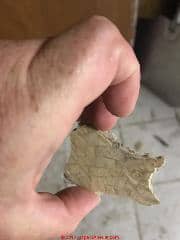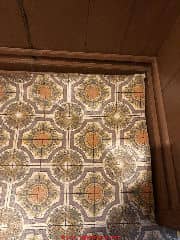 Congoleum Nairn Sheet Flooring & Floor Tile ID FAQs
Congoleum Nairn Sheet Flooring & Floor Tile ID FAQs
Q&A on Congoleum asbestos in some Congoleum
- POST a QUESTION or COMMENT about identifying Congoleum or Congoleum Nairn flooring materials & their asbestos content
Congoleum flooring identification & asbestos questions & answers.
This article series provides a guide to identifying traditional or early Congoleum rugs and other sheet flooring products, Congoleum-Nairn asphalt-asbestos, vinyl asbestos floor tiles, linoleum, and sheet flooring (resilient flooring).
Some of these Congoleum floor covering materials contain asbestos in asbestos fiber or asbestos powder-filler form.
InspectAPedia tolerates no conflicts of interest. We have no relationship with advertisers, products, or services discussed at this website.
- Daniel Friedman, Publisher/Editor/Author - See WHO ARE WE?
FAQs on Asbestos in Some Congoleum-Nairn Vinyl-Asbestos Floors
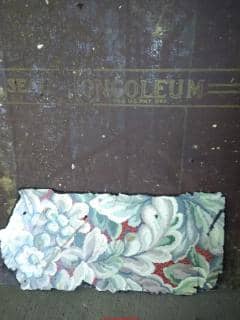 These questions and answers about Congoleum Nairn floor tiles and sheet flooring and about asbestos content in some Congoleum flooring products were posted originally
These questions and answers about Congoleum Nairn floor tiles and sheet flooring and about asbestos content in some Congoleum flooring products were posted originally
at CONGOLEUM-NAIRN FLOOR TILES & LINOLEUM - be sure to review that article.
[Click to enlarge any image]
On 2019-03-23 by (mod) - Does this contain asbestos thanks
Brian,
In the article CONGOLEUM-NAIRN FLOOR TILES & LINOLEUM, for older Congoleum red rubber-backed sheet flooring we noted that per one reader,
Congoleum Gold Seal Sheet Flooring ca 1950: test indicated No Asbestos Content
For the asphalt-paper backed sheet flooring (widely described as "linoleum"), our advice is to either have a sample of the flooring tested for asbestos or to presume that it contains asbestos, because at least some asphalt-impregnated felt paper used on buildings and as a flooring backer has been found to contain asbestos.
See details at 1950 CONGOLEUM GOLD SEAL SHEET FLOORING - No Asbestos
On 2019-03-23 by Brianastevens86@gmail
Does this contain asbestos thanks
On 2018-12-18 by (mod)
DT your stone-chip flooring looks a lot like an asbestos-containing sheet flooring pattern sold in North America at least in the 1960's.
On 2018-12-18 by DT
@RDJ,
Did you ever find out if that contained asbestos? We have the same all around our kitchen. Thanks..
On 2018-11-13 by (mod) - no asbestos in Congoleum Pacemaker II from 1982
Thank you so much for the follow-up. That would be helpful to other readers and I'll be sure to keep this information in the article serious. It's also a great tip to look for the date of trademark of some of these identifying stamps. Thanks again.
On 2018-11-13 by Anonymous
I got it tested for anyone concerned. "Pacemaker II" from Congoleum contained no Asbestos in it. The trademark for the stamp was issued in 1982.
On 2018-10-17 by (mod) -
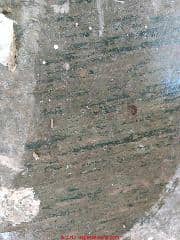 Honestly, Domanie, I'm not sure - that type of flooring pattern was popular over such a long period that it could be one that contained asbestos or it could be a later product.
Honestly, Domanie, I'm not sure - that type of flooring pattern was popular over such a long period that it could be one that contained asbestos or it could be a later product.
If you think it was installed before 1986 I would treat it as presumed to contain asbestos.
If you can leave it in place and cover it over that would be safest and least costly.
On 2018-10-17 by Domanie
Just bought a house built in 1890. Previous owner had covered all the floors and carpet and as I was tearing it up to get to the original wood,
I came across a floor that looked like it was linoleum.
It's in very bad shape, badly cracked and looks like someone tried to pry it up previously.
I would like to know if this looks like one of the linoleum brands I should be concerned about.
Heres a shot of the backing of the linoleum. Looks to be one sheet, not in tile form. Can't see any identifying logos or anything so far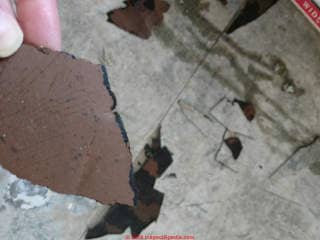
On 2018-06-04 by (mod) -
Amy your floor looks like an asbestos containing sheet flooring sold in the U.S. in the 1960's and 70's.
It would make sense to treat the flooring is presumed to contain asbestos or if you're facing an expensive demolition to have a sample tested
On 2018-06-03 by Amy
Bought an old historic building and found this under ceramic tile. It is flat and not embossed. Do I need to be concerned because I cannot match this pattern?
On 2018-04-27 by RDJ
This is an armstrong sheet product that is glued down to wood and concrete flooring in our newly acquired homebuilt in 1973 but we suspect the flooring is later in the 80's
Are there any reported asbestos issues with this flooring that are known to contain asbestos?
On 2016-04-01 by (mod) -
Anon:
Don't freak out - that's bad for your health and your wallet.
Do avoid creating a dusty mess, clean up properly, and treat the flooring and its adhesive as "PACM" or presumed asbestos containing material.
Or test it: ASBESTOS TESTING LAB LIST
Search InspectApedia.com for the following two articles that you'll want to read
ASBESTOS FLOORING HAZARD REDUCTION
ASBESTOS FLOORING REMOVAL GUIDE
On 2015-08-28 by Anonymous
I'm in Canada - My house was built in either 1973 or 1974 ... We purchased the house 5 years ago ... cracked ceramic tiles in the Kitchen ... I decided to remove them yesterday ... as i was breaking the tiles ... and trying to remove the glue ..
. I noticed what seems to be linoleum ... but not 100% positive .. then looking at the wood ... there's a black sticky tar ... when I goggled ... it says it may contain Asbestos ... what to do? ... I've removed nearly all the ceramic tiles ... had no protection whatsoever ... and I'm now freaking out
Question:
(July 8, 2014) Kimberly said:
Trying to identify the tile in our kitchen. House was built in 1970 in the Midwest, and underwent renovation in 1974. Tiles are brick shaped, 8 1/2 by 2 1/2, white with grey speckles and edges/mortar lines. Appear very rigid and durable. Thanks.
Reply:
Kimberly
there were several manufacturers of brick pattern asbestos containing floor tiles.
See inspectapedia.com/hazmat/Armstrong_Tile_List_1974-79.php Romford Brick patterns in white and red for examples.
Question: Benjamin floor tiles
Aug 8, 2014) Cathy Butler said:
Hello I own an asbestos testing laboratory and my lab manager calls some floor tiles "Benjamin tiles."
This is what they were called at her previous job. I'm unable
to fine any info using that name. Have you heard of Benjamin tiles? where did the name come from. Thank you.
Reply:
I've never heard of "Benjamin tiles" either, and would certainly be interested if your lab manager can give us some actual information. I'd be glad to research the topic given a clue, but I must gripe that having researched this topic for nearly two decades, that's not an asbestos floor tile name I've seen.
Perhaps she's referring to flooring products from Benjamin Moore? Principally a paint and floor coating company.
Question: did our linoleum contain asbestos?
(Dec 31, 2014) Celeste Malvar said:
we recently had two layers of linoleum removed from our kitchen floor and our contractor did no asbestos testing; how would I know if any asbestos fibres have been released into our home now?
Reply:
Celeste, if you *know* that the product was truly linoleum, that does not contain asbestos. Other sheet flooring products might. If the sheet flooring was glued down, some of those mastic adhesives also contained asbestos.
In ARTICLE INDEX see MASTIC, CUTBACK ADHESIVE, FLASHING CEMENT ASBESTOS
You could try taking a tape sample of settled dust that you think represents dust that might have been created by work on your home. Send that to a certified asbestos test lab.
See tape sampling procedure details at inspectapedia.com/mold/Mold_Test_Adhesive_Tape.php
Question: Congoleum Shinyl Vinyl dust hazard?
(Apr 13, 2015) Christy Spradling said:
My husband and I recently renovated our kitchen, and found Congoleum Shinyl Vinyl under another layer of linoleum.
We took it out in large pieces, and where it was completely stuck, I used a heat gun to pry it up. I used adhesive remover to get MOST of the backing left behind on the wood floor, and then we completely masked off the room when my husband (while wearing a respirator) took a palm sander to what was left to smooth out the floor.
Unfortunately, some of the dust from sanding got into the next room on the other side of the wall from under the baseboard. It was completely cleaned up by the next day, but 3 months later, I'm still having anxiety thinking we've poisoned our kids and doomed them to lung cancer in the future. Am I overreacting? We tried to hard to be careful with it, and I'm scared to death it wasn't enough.
Reply:
Look: we don't know (without a lab test) what was in the dust, how much dust you spread, what was the actual exposure to occupants. At this point, if there is more cleanup to be done use damp wipes or a HEPA-rated vacuum cleaner. You could also collect a tape sample of dust to have it analyzed by a forensic lab.
If asbestos particles are a significant portion of the dust then more cleanup would be appropriate. I understand the anxiety, but I'm doubtful that you'll find scholarly data asserting that your kids suffered a measurable health impact. So don't be scared to death. The anxiety itself is bad for you.
Question: Congoleum Nairn, Gold Seal Asphalt Tile 1/8 gauge, 9X9
5 June 2015 sueha417 said:
We live in a home that is 65 years old. There is carpeting covering asphalt tile in our basement.
We recently found a box of tiles (same as on the basement floor) that are labeled Congoleum Nairn, Gold Seal Asphalt Tile 1/8 gauge, 9X9. Does this manufacturer's line of tile contain asbestos? If so, it is a danger as long as it is under carpeting?
Reply:
Yes that's an asbestos containing floor tile - a claim you can confirm if you face significant costs - by sending a sample to a certified asbestos testing lab. It's not costly - about $50. USD.
Question:
(July 8, 2014) Kimberly said:
Trying to identify the tile in our kitchen. House was built in 1970 in the Midwest, and underwent renovation in 1974. Tiles are brick shaped, 8 1/2 by 2 1/2, white with grey speckles and edges/mortar lines. Appear very rigid and durable. Thanks.
Reply:
Kimberly
there were several manufacturers of brick pattern asbestos containing floor tiles.
See ASBESTOS FLOOR TILE IDENTIFICATION PHOTOS 1974-1979 for examples of Romford Brick patterns in white and red for examples.
Question: Asbestos in Benjamin floor tiles?
Aug 8, 2014) Cathy Butler said:
Hello I own an asbestos testing laboratory and my lab manager calls some floor tiles "Benjamin tiles."
This is what they were called at her previous job. I'm unable
to fine any info using that name. Have you heard of Benjamin tiles? where did the name come from. Thank you.
Reply:
I've never heard of "Benjamin tiles" either, and would certainly be interested if your lab manager can give us some actual information. I'd be glad to research the topic given a clue, but I must gripe that having researched this topic for nearly two decades, that's not an asbestos floor tile name I've seen.
Perhaps she's referring to flooring products from Benjamin Moore? Principally a paint and floor coating company.
Question: did our linoleum contain asbestos?
(Dec 31, 2014) Celeste Malvar said:
we recently had two layers of linoleum removed from our kitchen floor and our contractor did no asbestos testing; how would I know if any asbestos fibres have been released into our home now?
Reply:
Celeste, if you *know* that the product was truly linoleum, that does not contain asbestos. Other sheet flooring products might. If the sheet flooring was glued down, some of those mastic adhesives also contained asbestos.
In ARTICLE INDEX see MASTIC, CUTBACK ADHESIVE, FLASHING CEMENT ASBESTOS
You could try taking a tape sample of settled dust that you think represents dust that might have been created by work on your home. Send that to a certified asbestos test lab.
See tape sampling procedure details at inspectapedia.com/mold/Mold_Test_Adhesive_Tape.php
Question: Congoleum Shinyl Vinyl dust hazard?
(Apr 13, 2015) Christy Spradling said:
My husband and I recently renovated our kitchen, and found Congoleum Shinyl Vinyl under another layer of linoleum. We took it out in large pieces, and where it was completely stuck, I used a heat gun to pry it up
I used adhesive remover to get MOST of the backing left behind on the wood floor, and then we completely masked off the room when my husband (while wearing a respirator) took a palm sander to what was left to smooth out the floor.
Unfortunately, some of the dust from sanding got into the next room on the other side of the wall from under the baseboard.
It was completely cleaned up by the next day, but 3 months later, I'm still having anxiety thinking we've poisoned our kids and doomed them to lung cancer in the future. Am I overreacting? We tried to hard to be careful with it, and I'm scared to death it wasn't enough.
Reply:
Look: we don't know (without a lab test) what was in the dust, how much dust you spread, what was the actual exposure to occupants. At this point, if there is more cleanup to be done use damp wipes or a HEPA-rated vacuum cleaner. You could also collect a tape sample of dust to have it analyzed by a forensic lab.
If asbestos particles are a significant portion of the dust then more cleanup would be appropriate. I understand the anxiety, but I'm doubtful that you'll find scholarly data asserting that your kids suffered a measurable health impact. So don't be scared to death. The anxiety itself is bad for you.
Question: Congoleum Nairn, Gold Seal Asphalt Tile 1/8 gauge, 9X9
5 June 2015 sueha417 said:
We live in a home that is 65 years old. There is carpeting covering asphalt tile in our basement. We recently found a box of tiles (same as on the basement floor) that are labeled Congoleum Nairn, Gold Seal Asphalt Tile 1/8 gauge, 9X9. Does this manufacturer's line of tile contain asbestos? If so, it is a danger as long as it is under carpeting?
Reply:
Yes that's an asbestos containing floor tile - a claim you can confirm if you face significant costs - by sending a sample to a certified asbestos testing lab. It's not costly - about $50. USD.
...
Continue reading at CONGOLEUM-NAIRN FLOOR TILES & LINOLEUM or select a topic from the closely-related articles below, or see the complete ARTICLE INDEX.
Or see this
Article Series on Congoleum Flooring
- ASBESTOS TESTING LAB LIST
- CONGOLEUM FLOORING HISTORY
- CONGOLEUM-NAIRN FLOOR TILES & LINOLEUM
- 1928 CONGOLEUM RUGS SHEET FLOORING - Canadian Congoleum
- 1940s CONGOLEUM FLORAL RUG PATTERNS
- 1947 CONGOLEUM SHEET FLOORING
- 1940s CONGOLEUM GOLD SEAL RUGS vs. NAIRN LINOLEUM ingredient differences
- 1950 CONGOLEUM GOLD SEAL SHEET FLOORING - No Asbestos
- 1950's CONGOLEM SHEET FLOORING Products Resembling Individual Floor Tiles
- 1960's CONGOLEUM FLOORING - No Asbestos
- 1970's CONGOLEUM FLOORING
- 1970's CONGOLEUM FLOORING in AUSTRALIA
- 1980 CONGOLEUM NO-WAX SHEET FLOORING - With Asbestos-Content.
- CONGOLEUM FLOORING HISTORY
- DOES THIS FLOOR CONTAIN ASBESTOS? - 5 easy questions to tell if your FLOOR probably contains asbestos -
- DOES THIS MATERIAL CONTAIN ASBESTOS? - 5 easy questions to tell if a BUILDING MATERIAL probably contains asbestos -
- DOMINION & Other CANADIAN FLOORING ASBESTOS
- FLOOR TILE / SHEET FLOORING PHOTO GUIDES
- IDENTIFY SHEET FLOORING TYPE, HOW TO
- LINOLEUM & OTHER SHEET FLOORING - home
- SHEET FLOORING INSPECT / TEST
- WHITE SHIELD® BACKING ASBESTOS in FLOORING
Suggested citation for this web page
CONGOLEUM-NAIRN FLOOR TILES & LINOLEUM FAQs at InspectApedia.com - online encyclopedia of building & environmental inspection, testing, diagnosis, repair, & problem prevention advice.
Or see this
INDEX to RELATED ARTICLES: ARTICLE INDEX to ASBESTOS HAZARDS
Or use the SEARCH BOX found below to Ask a Question or Search InspectApedia
Ask a Question or Search InspectApedia
Try the search box just below, or if you prefer, post a question or comment in the Comments box below and we will respond promptly.
Search the InspectApedia website
Note: appearance of your Comment below may be delayed: if your comment contains an image, photograph, web link, or text that looks to the software as if it might be a web link, your posting will appear after it has been approved by a moderator. Apologies for the delay.
Only one image can be added per comment but you can post as many comments, and therefore images, as you like.
You will not receive a notification when a response to your question has been posted.
Please bookmark this page to make it easy for you to check back for our response.
IF above you see "Comment Form is loading comments..." then COMMENT BOX - countable.ca / bawkbox.com IS NOT WORKING.
In any case you are welcome to send an email directly to us at InspectApedia.com at editor@inspectApedia.com
We'll reply to you directly. Please help us help you by noting, in your email, the URL of the InspectApedia page where you wanted to comment.
Citations & References
In addition to any citations in the article above, a full list is available on request.
- In addition to citations & references found in this article, see the research citations given at the end of the related articles found at our suggested
CONTINUE READING or RECOMMENDED ARTICLES.
- Carson, Dunlop & Associates Ltd., 120 Carlton Street Suite 407, Toronto ON M5A 4K2. Tel: (416) 964-9415 1-800-268-7070 Email: info@carsondunlop.com. Alan Carson is a past president of ASHI, the American Society of Home Inspectors.
Thanks to Alan Carson and Bob Dunlop, for permission for InspectAPedia to use text excerpts from The HOME REFERENCE BOOK - the Encyclopedia of Homes and to use illustrations from The ILLUSTRATED HOME .
Carson Dunlop Associates provides extensive home inspection education and report writing material. In gratitude we provide links to tsome Carson Dunlop Associates products and services.


